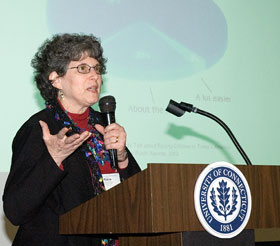  |
| HOME | THIS ISSUE | CALENDAR | GRANTS | BACK ISSUES | < BACK | NEXT > |
Games, toys inhibit kids’ creativityby Sherry Fisher - April 10, 2006 |
||||
|
Video games, electronic toys, and advertisements that target children are stifling their creativity, blurring their understanding of the world, and turning them into ultimate consumers, says Diane Levin, author of Remote Controlled Childhood? Combating the Hazards of Media Culture.
Media affect every aspect of children’s lives and have become a challenge for teachers and parents to counter, Levin said during an all-day conference promoting media literacy on March 31 in Bishop Center. The conference, “Rethinking Media Literacy in a Changing Youth Culture,” was sponsored by the Neag School of Education. Levin, an education professor at Wheelock College, is an internationally recognized expert on helping teachers and parents deal with the effects of violence, media, and commercial culture on children. Imaginative play is essential to children’s well-being, but it is quickly disappearing, Levin said. “When children are playing video games, they’re involved with what someone else has created. Children are not in charge of what happens; they’re figuring out what the programmer intended them to do. “Even when we do get children to read books, the books become movies, which become sources of commercialism,” Levin said. “Everything you do from morning till night becomes something you can buy.” She said every time there’s a blockbuster movie, a new game comes out, and she gave Star Wars Monopoly as an example. “I still have my 50-year-old Monopoly game, but now it’s become obsolete,” she said. “Children want the one that’s connected to the latest movie.” The influence of media also has made raising a child difficult, she said. “Four years ago, more than 75 percent of parents said it was harder to raise children compared to when they were growing up.” Levin said even children from birth to three-years-old have televisions in their bedrooms, and 43 per cent of four to six-year-olds have televisions in their rooms. Many three, four, and five-year-olds have toys based on movies that were rated PG-13, such as Hulk Hands, which several years ago received one of the 10 Best Toys of the Year award. When smacked together, the hands make snarling sounds and noise like glass breaking. “That is not play,” Levin said. “Play is supposed to help children take risks, master things, and develop the sense of ‘I can do it,’” she added. “Instead, it’s ‘Can I do what someone else has programmed for me?” Levin said that toys for girls are “about how they’re supposed to look and what they’re supposed to buy. It makes girls think of themselves as objects.” She described the doll and clothing kit, Bratz Funk N’ Glow, as “mindless and a best-seller.” Levin said those who are concerned can help meet children’s needs by developing TV rules that limit the amount of time children spend in front of the television; creating appealing alternatives to screen time; and discussing advertisements with children. In a separate interview, Thomas Goodkind, a professor of curriculum and instruction who organized the conference, said parents and teachers need to be invested in the importance of media literacy and incorporate it into school programs. “I’m concerned about the ever present massive force aimed at children,” said Goodkind, who incorporates media literacy into all his courses. “They’re easy targets. We need to help them deconstruct many of the messages they’re getting.” |
| ADVANCE HOME UCONN HOME |

